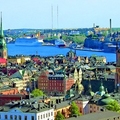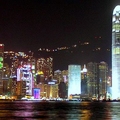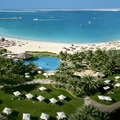Destinations / The best capital cities in the world / Berlin
Ads
Berlin
Sponsored Links
Berlin is the capital of Germany, located in the northeastern part of the country. The fantastic city was the capital of a united Germany from 1871 to 1945 and again since 1990. It lies beautifully on the flatlands of the North German Plain at the confluence of several rivers and amid many lakes. The city’s favorable position made it a great site for human settlements starting with the prehistoric times. It is situated on the river Spree and comprises a population of about 4 million inhabitants with an area of about 900 km ². Berlin also represents one of the greenest cities in Europe, where over 60 percent of the total area is represented by parks and rivers.
The significant events of the past left their mark on the cityscape, and there are some traits that make it one of Europe's most vibrant, exciting and colourful capitals of the world. Berlin is an exciting city of contrasts and continual changings. Forever evolving it can be discovered in a countless variety of historical and modern attractions. Berlin is one of the best European cities that offers a perfect blend of history, entertainment, architecture and culture. It is a place that has something to offer for everyone. It seems very hard to find another city in Europe to have such a vibrant nightlife, ideal for those who want to have fun in different clubs, always full of tourists and Berliners. The residents of Berlin are usually friendly, hospitable and open to newcomers, treating them with respect and amability.
Major attractions in Berlin
Charlottenburg Palace
Charlottenburg Palace represents an early 18th century palace made in a baroque style, located in Berlin's western Charlottenburg district. During the Second World War the structure burned totally but later it was completely rebuilt. Charlottenburg Palace is the largest palace of its kind in Berlin. Its central part, and the original one was founded between the 1695 and 1699. The Palace was the summer residence for Sophie Charlotte, who was the wife of the Elector of Brandenburg, Frederick III. The magnificent palace was designed by Johann Arnold Nering. The Swedish master Johann Friedrich Eosander von Göthe was the supervisor of the expansion, which included the addition of the 48 meter tall copula, and also the construction of the orangery at the west wing. On the top of the copula was placed the statue of Goddess Fortuna.
The west wing was constructed very long and was completed six years later after a design made by Georg Wenzeslaus von Knobelsdorff. The interior was beautifully reconstructed and redesigned. The royal rooms are very elegant and sophysticated, and are open to visitors. Very special is the Oak Gallery, paneled with oak and lined with oil paintings. The Porcelain Gallery is carefully decorated with mirrors, and features a wonderful display of Chinese porcelain. Other beautiful rooms include the White Hall, the rococo style Golden Gallery and The Gallery of the Romantics, which comprises a fine collection of paintings that date back to the German Romantic period.
Charlottenburg Palace includes an incredible park behind it, that was originally designed in French Baroque style. Between the 18th and the 19th century, the park was transformed into a landscaped garden. After the war the park was reconstructed too and a small part was laid out in French style again. In the park the visitors can see many buildings such as the mausoleum, a Doric temple built in 1810, being the burial place for members of the royal family. Another famous building in the garden is the Belvedere, built between 1788 and 1790 as a teahouse.
At the entrance of the palace stands a huge and delicate statue of the Great Elector. The statue was designed in 1698 by Andreas Schlüter and planned by king Friedrich I, who was the son of the famous elector. At the base of the statue stand four chained warriors, symbolizing the four temperaments.
The Pergamon Museum in Berlin
The Pergamon Museum is the newest museum in Berlin’s Museum Island, first opened in 1930. It has the name dedicated to the Pergamon Altar, an imposing monument that occupies a whole room. The museum was designed by Alfred Messel, and later by Ludwig Hoffman, and was erected to be added to the Kaiser-Wilhelm Museum which became too small to include all the artifacts garnered from the German excavations throughout the world.
The idea for the construction of the new museum appeared in 1907, and it took 20 years to complete the fantastic structure. The museum was opened during one of the country's most turbulent periods and was largely destroyed during the Second World War. Fortunately, the majority of the pieces had been stored in another place for safety, and many of the museum's larger pieces were simply "walled in" for protection. The Pergamon Museum consists of three distinct sections such as the Antiquity Collection, the Islamic Art Museum, and the Near East Museum.
The section of the Greek and the Roman Antiquities is the most magnificent part of the museum, where the guests will be invited to see several large-scale pieces, like the Pergamon Alatar, which is giant and occupies an entire room. Constructed in Pergamon, Asia Minor, to be the altar to Zeus, the gigantic structure represents the centerpiece of the museum. The Near East Museum boasts one of the largest and the best collections of antiquities from the ancient Babylonia, Persia, and Assyria. The Islamic Art Museum is based on the Middle East including Egypt and Persia, featuring pieces of art that belong to the 8th and the 9th centuries. The guests can admire original architectural decorations, ceramics, jewelry, metalwork, wood carvings, textiles, and calligraphic works.
The Berlin Wall
The Berlin Wall, was a barrier that separated the city in an eastern and western part, the symbol of the Cold War. The wall was built by the goverment to prevent the escapes of the East Germans to the West. Most of the Berlin Wall had been demolished when the border between the East and the West Berlin was officially opened in 1989.
Until 1961, the East Germans had free access to move between the Western and Eastern parts of Berlin. But many East Berliners were attracted by the more prosperous West, and moved there. On August 12, 1961 the East German authorities closed the border around the Western sectors of Berlin in order to prevent people from fleeing. On the next day, the West Berlin was surrounded by barbed wire. Traffic at the borders was interrupted, the underground and S-bahn connecting the different sides of the city were closed. At the eastern side of the border the houses were evacuated and the windows were bricked up. Along the Wall's east side a „death zone” ran, an area controlled only by guards. Over 302 watchtowers and 20 bunkers were founded along the 155km long border. The guards had the order to shoot at escapees, and as a result 192 people were killed when trying to cross the border to the West.
Finally on November 9, 1989, the travel restrictions were lifted, and the border’s gates opened, people were given the opportunity to go in the West Berlin. Most of the wall had been destroyed, but some parts still exist. The most famous one is the 1316m long East Side Gallery which contains 106 paintings.
Kaiser Wilhelm Memorial Church
The Kaiser Wilhelm Memorial Church is one of the most famous landmarks in Berlin. The damaged tower that still stands there, is a constant reminder of the destruction of the war. The church is a wonderful structure, located at the Breitscheidplatz, the center of former West-Berlin. The imposing building was founded between 1891 and 1895 by Kaiser Wilhelm II. The church rises up as a symbol of Prussian unity and a mark of honor, dedicated to his grandfather, Kaiser Wilhem I. The neo-romanesque structure was designed by the German architect Franz Schwechten. The building was decorated with special ornaments for a protestant church. The interior includes a large mosaic depicting the history of Prussia.
This amazing church burned down on November 18,1943, because of an allied bomb that hit the structure. Only the broken west tower of the church was still standing. Between 1950 and 1961 a new, octagonal church was founded along the existing tower, designed by Egon Eiermann. The present church represents a reinforced concrete building that features blue-colored glass bricks.
On the site of the former main nave of the destroyed church was erected a freestanding tower, in a hexagonal form.
Berliner Dom
The Berliner Dom is a baroque Cathedral that was founded between 1894 and 1905. The remarkable dom is located on an island in the river Spree, known as the Museum Island. The present structure is the third church built at this location. The first church was built on this area in 1465. The modest church later was used as the court church for the Hohenzollern family. The majestic structure was replaced by a cathedral, constructed between 1745 and 1747 in a Baroque style. From 1816 to 1822 it was remodeled and transformed into a classicist structure following the design of the architect Karl Friedrich Schinkel.
Due to the order of the Emperor Wilhelm II, this domed building was destroyed in 1894 and replaced with the present Cathedral. The cathedral is designed in a baroque style with Italian Renaissance influences, decorated by Julius Raschdorff. It is unusually and very special ornated for a protestant church. The process of construction lasted from 1894 until 1905 and has a lenght of about 114 metres and 73 metres width.
During the Second World War, the building was hit by a fire bomb that created severely damages and much of the Cathedral burned. A roof was installed to preserve the remains of the interior. In 1975 the reconstruction of the church started, despite plans of the government that wanted to demolish the building. The interior’s renovation began in 1984 and in 1993 the church was officially reopened to the public. The most interesting item in the elegantly decorated interior of the church is the pipe organ, which was built by Wilhelm Sauer. The restored organ originally constructed in 1905 includes over 7.000 pipes. Some members of the Hohenzollern family are burried in the church. The oldest tomb in the cathedral is that of the elector Johann Cicero, the elector of Brandenburg. The main altar, saved from the previous cathedral dates back to 1850.
Holocaust Memorial
The Holocaust Memorial appeared as an idea in 1988, but its design was not approved until 1999. The design was made by Eisenman, and was unique and original, drawn both praise and criticism. The Holocaust Memorial covers and area of about 205,000 square feet , located near the Brandenburg Gate. The memorial is made up of 2,711 gray stone slabs, that feature no dates or names on it.
Each of the slabs is a five-sided monolith, unique in shape and size. The visitors can take a pleasant walk through the memorial in any direction, admiring the enchanting place, dedicated to those Jews who were killed by Hitler. This place is a gorgeous area, where the visitors can spend some peaceful moments, commemorating the unfortunate people who died. It is a quite and silent place, veiled in a majestic air of tranquility.
Postdamer Platz
The Potsdamer Platz was completely destroyed after the Second World War. In 1998 the new Potsdamer Platz was officially opened full of excellent and modern buildings. For a long period the Potsdamer Platz existed as one of the busiest and lively squares in Europe. It represented an important public transport hub and a popular entertainment area, housing many nice bars, cafés and cinemas.
But there happened something disastruous when the platz was left to ruins by allied bombing. After the war, the square that was beautifully located between the American, British and Russian sectors, was reconstructed, and covered an area of about 480,000 square metres. The process of the construction started in 1994 and for many years Postdamer Platz became the largest construction in the whole Europe.The spacious square, including the adjacent blocks were redeveloped, having as supervisors the architects Wilmer and Sattler. The initiated project included the construction of some lovely landmark towers, a shopping arcade, an entertainment center and residential buildings.
The first building that was constructed was the Debis Tower, beautifully designed by Renzo Piano. Other remarkable structures are the Sony Center, a splendid complex designed by Helmut Jahn which features an Imax theater and an office tower.
These are just some treasured attractions that Berlin includes . The capital city is filled with wonderful sights that are must-visit landmarks, which attract through their immensity, originality and picturesque beauty. There are some adorable museums, squares, churches that are worth to be visited, as they relate some exciting memories. Berlin is a vibrant city, that offers exciting adventures, a perfect destination for your relaxing vacation. The city has incredible places that are fruly overwhelming, offering some stunning panoramas, where the guests are enchanted and spend really lovely moments, with their beloved ones.
Sponsored Links
By Eugenia Cvasov
Sponsored Links
Others The best capital cities in the world .
Others from The best capital cities in the world
Is there a person who doesn't like to travel? I think no.
Who doesn't wish for an exciting vacation or who isn't attracted by fascinating experiences? This poll provides comprehensive information about the best, most important capital cities in the world that we generally recommend as wonderful places to explore.
Let them be your starting point and consider these places might occur to you and suit your goals.
These are the most liveable,friendly and multicultural cities on Earth, with the most exciting cultures,with the most beautiful beaches, with the most lively nightlife and the most beautiful scenery.
Explore the cities and find out the best kept secret of each of them.
I'm sure you'll experience senses to the fullest intensity.
Who doesn't wish for an exciting vacation or who isn't attracted by fascinating experiences? This poll provides comprehensive information about the best, most important capital cities in the world that we generally recommend as wonderful places to explore.
Let them be your starting point and consider these places might occur to you and suit your goals.
These are the most liveable,friendly and multicultural cities on Earth, with the most exciting cultures,with the most beautiful beaches, with the most lively nightlife and the most beautiful scenery.
Explore the cities and find out the best kept secret of each of them.
I'm sure you'll experience senses to the fullest intensity.
Images of Berlin, icons, photos, figures, visions, appearances, illustrations, snapshots, captures, canvas and pictures of Berlin - The best capital cities in the world
Sponsored Links
Sponsored Links






















